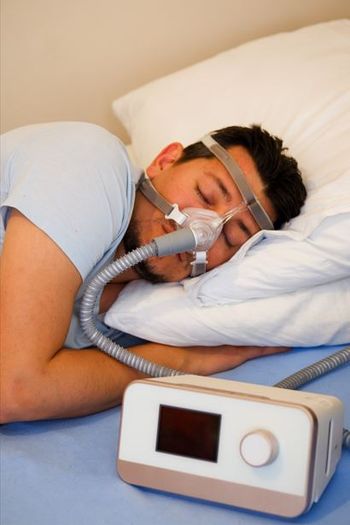
The Journal of Respiratory Diseases
- The Journal of Respiratory Diseases Vol 5 No 12
- Volume 5
- Issue 12
Clinical Update: Heparin-induced thrombocytopenia: Highlights of recent studies
Heparin-induced thrombocytopenia (HIT) is a potentially life-threatening complication that occurs in about 1% to 5% of patients who receive heparin.1 Patients with HIT are at risk for the development of new thrombosis, including pulmonary embolism (PE). The mortality rate among patients with HIT and thrombosis is about 20% to 30%.2-5
Heparin-induced thrombocytopenia (HIT) is a potentially life-threatening complication that occurs in about 1% to 5% of patients who receive heparin.1 Patients with HIT are at risk for the development of new thrombosis, including pulmonary embolism (PE). The mortality rate among patients with HIT and thrombosis is about 20% to 30%.2-5
This Clinical Update summarizes the results of several recent studies on HIT. These studies address the risk of HIT in patients receiving unfractionated heparin (UFH) versus low molecular weight heparin (LMWH), the risks of thrombotic complications, the use of argatroban in patients with renal failure, and transitioning from argatroban to warfarin therapy.
Comparing HIT risk with UFH vs LMWH
Martel and colleagues6 performed a meta-analysis of 15 studies that assessed HIT or thrombocytopenia in patients receiving prophylaxis with UFH or LMWH. Most of the studies included patients who had undergone orthopedic surgery; a total of 7287 patients were included.
The results indicated that the risk of HIT was lower in patients receiving LMWH than in those receiving UFH.6 The odds ratios were the same (0.10), regardless of whether the analysis included randomized trials or all prospective studies with comparator groups. The absolute risk of HIT was 0.2% in patients receiving LMWH, compared with 2.6% in those receiving UFH.
The authors noted that the pathophysiology of HIT may be different in LMWH than in UFH because of the difference in molecule size.6 They pointed out that LMWH is at least as effective as UFH, and it may actually be the less expensive alternative if the costs of managing HIT are taken into account.
Risk factors for thrombosis
Greinacher and coworkers7 retrospectively studied 408 patients with HIT. Thromboembolic complications developed in 55.6% of patients (Table 1). Most of these complications involved venous thrombosis (70.8%). However, there was a predominance of arterial thrombosis in a subset of patients who had undergone cardiovascular surgery. PE developed in 40% of patients with venous thromboembolic complications.
In close to 60% of patients, the complications appeared either before or on the same day that the platelet count fell by more than 50%.7 Orthopedic/trauma surgery was an independent risk factor for HIT-associated thrombosis (odds ratio, 5.3).
Managing HIT in patients with renal failure
The management of HIT includes immediate cessation of heparin and initiation of alternative anticoagulation. Argatroban and lepirudin have been demonstrated to improve clinical outcomes in patients with HIT.3-5 Since lepirudin is renally cleared, it should be avoid- ed in patients who are undergoing hemodialysis.
Reddy and coworkers8 conducted a study to assess the effectiveness and safety of argatroban for HIT in this setting. They retrospectively studied 47 patients with HIT who required renal replacement therapy for renal failure. The typical starting dose of argatroban was 2 µg/kg/min in the absence of hepatic impairment and less than 1.5 µg/kg/min in patients with hepatic impairment. The median infusion doses were 1.7 µg/kg/min and 0.7 µg/kg/min in patients with and without hepatic impairment, respectively. The corresponding activated partial thromboplastin times (aPTTs) were 2.2 and 2.0, relative to baseline.
New thrombosis developed in 2 patients (4%) during argatroban therapy.8 No patients died of thrombosis. Major bleeding occurred in 3 (6%) of 50 treatment courses.
The authors concluded that argatroban is effective and safe in patients who require renal replacement therapy.8 In addition, they concluded that the current dosing recommendation is adequate for these patients.
Transitioning from argatroban to warfarin
Argatroban is a direct thrombin inhibitor that is indicated for prophylaxis or treatment of thrombosis in patients with HIT. Patients treated with argatroban may require long-term anticoagulation with warfarin. The aPTT is routinely monitored in patients receiving argatroban or other direct thrombin inhibitors. These agents also prolong the international normalized ratio (INR).
Hursting and associates9 monitored INR and aPTT in 165 patients with HIT who were being transitioned from argatroban to warfarin therapy. This transitioning was done in the absence of specific guidelines. The median dosage of argatroban was 1.5 to 2 µg/kg/ min, and the median dosage of warfarin was 5 mg initially and 3.8 mg/d thereafter. Argatroban and warfarin therapy overlapped for a median of 4 days. The median aPTTs and INRs during therapy are shown in Table 2.
Major bleeding occurred in 1 patient (0.6%) before transitioning and in no patients during or after co-therapy.9 Peritransitional adverse outcomes, including death (1), amputation (2), and new thromboses (16), occurred in 18 (10.9%) patients. Those who experienced an adverse outcome had more severe HIT than those who were event-free.
A therapeutic INR was achieved in 43 of 108 patients for whom post-transitional INR data were available; 34 had subtherapeutic INRs, and 31 had supratherapeutic INRs.
The authors concluded that in the absence of guidelines, patients with HIT can be transitioned from argatroban to warfarin therapy without an unacceptable rate of complications and without systematically overdosing or underdosing warfarin.9 INRs of greater than 5 frequently occur in patients with HIT who are receiving argatroban monotherapy or co-therapy without major bleeding.
References:
REFERENCES
1. Warkentin TE, Sheppard JI, Horsewood P, et al. Impact of the patient population on the risk of heparin-induced thrombocytopenia.
Blood.
2000; 96:1703-1708.
2. Warkentin TE, Kelton JG. A 14-year study of heparin-induced thrombocytopenia.
Am J Med.
1996;101:502-507.
3. Lewis BE, Wallis DE, Berkowitz SD, et al. Argatroban anticoagulation therapy in patients with heparin-induced thrombocytopenia.
Circulation.
2001;103:1838-1843.
4. Lewis BE, Wallis DE, Leya F, et al. Argatroban anticoagulation therapy in patients with heparin-induced thrombocytopenia.
Arch Intern Med.
2003;163:1849-1856.
5. Greinacher A, Volpel H, Janssens U, et al. Recombinant hirudin (lepirudin) provides safe and effective anticoagulation in patients with heparin-induced thrombocytopenia: a prospective study.
Circulation.
1999;99:73-80.
6. Martel N, Lee J, Wells PS. Risk for heparin-induced thrombocytopenia with an unfractionated and low-molecular-weight heparin thromboprophylaxis: a meta-analysis.
Blood.
2005; 106: 2710-2715.
7. Greinacher A, Farner B, Kroll H, et al. Clinical features of heparin-induced thrombocytopenia including risk factors for thrombosis. A retrospective analysis of 408 patients.
Thromb Haemost.
2005;94:132-135.
8. Reddy BV, Grossman EJ, Trevino SA, et al. Agratroban anticoagulation in patients with heparin-induced thrombocytopenia requiring renal replacement therapy.
Ann Pharmacother.
2005; 39: 1601-1605.
9. Hursting MJ, Lewis BE, Macfarlane DE. Transitioning from argatroban to warfarin therapy in patients with heparin-induced thrombocytopenia.
Clin Appl Thromb Hemost.
2005;11:279-287.
Articles in this issue
about 20 years ago
Indoor mold and your patient's health: From suspicion to confirmationabout 20 years ago
Extrapulmonary tuberculosis, part 4: Skeletal involvementabout 20 years ago
Diagnostic Puzzlers: The case of unresolving pneumothoraxNewsletter
Enhance your clinical practice with the Patient Care newsletter, offering the latest evidence-based guidelines, diagnostic insights, and treatment strategies for primary care physicians.
































































































































































































































































































































